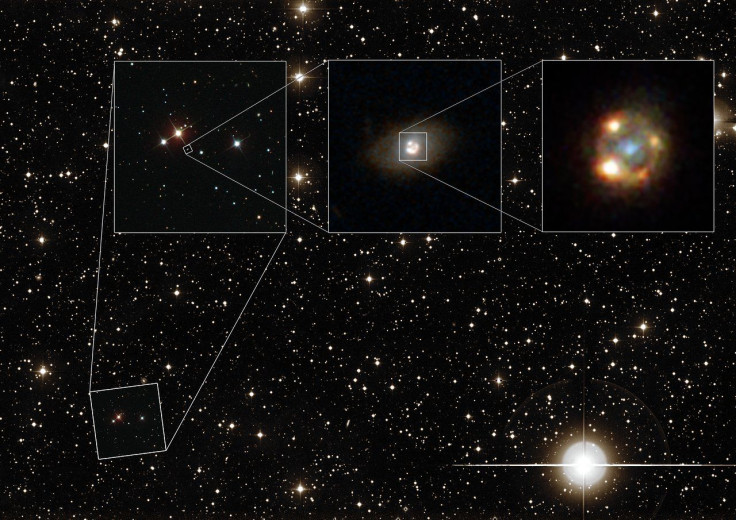In A First, Gravitational Lens Reveals Magnified And Multiplied Images Of A Type 1a Supernova

Astronomers have, for the first time, detected a gravitationally lensed type 1a supernova — objects that always explode with the same brightness, and are thus one of the “standard candles” used to gauge distance in the cosmos. The lensed images of this supernova, seen as it existed over 4.3 billion years ago, could help scientists accurately pin down the value of the Hubble Constant — a unit used to measure the rate of universe's expansion.
The images were captured using the the Hubble Space Telescope, Keck telescope on Mauna Kea, Hawaii, and the European Southern Observatory’s Very Large Telescope in Chile.
“Resolving, for the first time, multiple images of a strongly lensed standard candle supernova is a major breakthrough,” Ariel Goobar, a professor in the department of physics at Stockholm University, and lead author of a study detailing the observation, said in a statement. “We can measure the light-focusing power of gravity more accurately than ever before, and probe physical scales that may have seemed out of reach until now.”
Gravity, as Einstein’s theory of general relativity tells us, warps space-time. Occasionally, when the stars are aligned just right, this warping of the fabric of the universe results in a phenomenon known as gravitational lensing, wherein the strong gravitational field of a foreground object acts as a lens that “bends” light from an object in the background and allows scientists to catch a glimpse of what might otherwise have remained invisible.
In this particular case, the lensing object was a foreground galaxy located 2 billion light-years from Earth. As the light from the background supernova, named iPTF16geu, passed through the galaxy on its way to Earth, it not only magnified its image, but also multiplied it. The four images of the supernova lie on a circle with a radius of only about 3,000 light-years around the foreground galaxy, making it one of the smallest extragalactic gravitational lenses discovered so far.
“There are billions of galaxies in the observable universe and it takes a tremendous effort to look in a very small patch of the sky to find these kind of events. It would be impossible to find an event like this without a magnified supernova directing you where to look,” Goobar said. “We got very lucky with this discovery because we can see the small scale structures in these galaxies, but we won’t know how lucky we are until we find more of these events and confirm that what we are seeing isn’t an anomaly.”
Type 1a supernovae are often called standard candles because these objects, which occur in a binary system consisting of at least one white dwarf, always explode with the same brightness. Scientists believe that determining how long it takes for the light to reach Earth from each of the four lensed images of this particular supernova could provide a much more precise estimate of the value of the Hubble Constant. This, in turn, can be used to test key cosmological theories about the universe’s expansion and the distribution of dark matter and dark energy.
“When people measure the expansion rate of the universe now locally using supernovae or Cepheid stars they get a different number from those looking at early universe observations and the cosmic microwave background. There is tension out there and it would be neat if we could contribute to resolving that quest,” Goobar said.
© Copyright IBTimes 2024. All rights reserved.





















